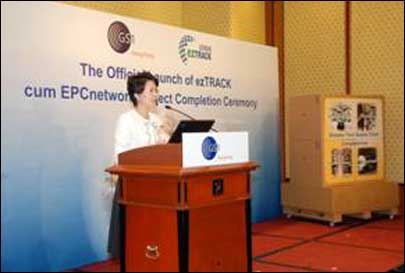GS1 Hong Kong has launched an online track-and-trace platform to provide end-to-end supply chain visibility for global businesses operating out of Hong Kong and China.
Last year, the organization completed a two-year pilot project to test the use of Electronic Product Code (EPC) and RFID infrastructures between manufacturers, logistics providers and retailers in China, Hong Kong and the United States (see EPCglobal Hong Kong Wraps Two-Year, Multi-Company RFID Project). Four companies tested EPC RFID tags, interrogators and systems integration services as goods crossed borders and traversed supply chains from China’s Pearl River Delta region to Hong Kong and several overseas destinations. The Pearl River Delta region is home to vast amounts of manufacturing companies that export goods overseas.
GS1 Hong Kong wanted to build an RFID infrastructure employing EPCglobal standards and services, including the Electronic Product Code Information Service (EPCIS), a standard enabling businesses to exchange RFID and product data in real time, and the EPC Network, a suite of network services for sharing RFID data. The online platform ezTrack, also based on EPC RFID standards, allows companies to plug into a Web application without further IT investment; businesses can then trace goods from the point of manufacture, in transit, through to the point of sale.
Anna Lin, GS1 Hong Kong’s chief executive, says the online platform will enable smaller firms in the region to adopt EPC-based RFID. “A shared software infrastructure online will allow companies of different sizes in the Pearl River Delta region to access RFID,” she says. The companies will still need to invest in RFID hardware, including EPC tags and interrogators, but they will not have to spend huge amounts on software and licensing.
“It will be particularly useful for small and medium-sized enterprises (SMEs) that do not want to invest in substantial back-end systems,” Lin says. “But it will also help big businesses that do not want to tightly integrate their back-end systems with RFID software. With very little investment, companies will be able to take up RFID.”
The ezTrack platform enables companies to access information regarding RFID-tagged goods moving through the supply chain, such as inventory data, progress status and delivery schedules. For an annual subscription fee, businesses receive access to ezTrack. The plug-and-play Web application ezTrack requires no IT infrastructure investment to implement or upgrade, and is scalable to incorporate future EPC-based technologies and services. The platform is interoperable with existing enterprise resource planning (ERP) software and warehouse management software (WMS) systems, provided they comply with the EPCIS standard, and allows smooth connections with existing international standard-based network platforms to exchange real-time supply chain data.
“It doesn’t matter what RFID technology or back-end systems a business has,” Lin says. “If it is EPCIS-compliant, different companies can talk to each other. Companies have to communicate, and this reduces the cost of information exchange.” The ezTrack platform is managed by Hong Kong RFID technology provider Autotoll Limited.
The ability to track and trace goods and quickly respond to market needs, Lin claims, is vital for a modern logistics supply chain, particularly as manufacturing in the Pearl River Delta region requires goods to cross borders several times. For instance, during a two-year pilot of EPC-based RFID infrastructures funded by the Hong Kong Special Administrative Region (SAR) government’s Innovation and Technology Commission, one shirt manufacturer tracked the movement of materials as they crossed the Hong Kong-China border multiple times throughout production. That company, Esquel Group, often ships materials numerous times between its processing plants, one of which is located in an industrial area of Hong Kong, the other on mainland China. RFID enabled the firm to track materials at any time given during the production process.
In addition, Lin says, RFID could allow businesses to share data with Chinese and Hong Kong customs organizations, to expedite the custom clearance process and speed the movements of goods. “There are many factors driving the need to adopt EPC RFID,” she notes. “Retailers such as Wal-Mart have already adopted RFID to exchange product data with suppliers, often requiring suppliers to meet these conditions.”
Lin describes a variety of needs that can be met through the adoption of EPC-based RFID. “Many manufacturers struggle to know all aspects of their business because they work across different locations,” she says. “Manufacturers, logistics providers and retailers need to know about their inventory for production planning and monitoring to logistics scheduling, dealing with out-of-stock situations and product quality management. A globalized track-and-trace platform that provides real-time visibility of goods will help companies improve operational management and enable them to get products to market much quicker.”
During the pilot project, Lin says, some companies recorded efficiency improvements of up to 15 percent—in a manufacturing environment, she says, poor information on goods and materials can hold up production. With the addition of ezTrack, more businesses in the region could achieve similar results. According to Lin, ezTrack will begin a new chapter for Hong Kong and the Pearl River Delta region by providing a ready-to-go, standards-based community service open to any business in the region.
“Hong Kong is an important trading hub, and ezTrack will ensure we remain a leading logistics and information hub,” Lin states. “It will link the logistical supply chain to manufacturers and allow us to stay ahead of the competition, deliver better customer service and be more competitive in the global market.”


